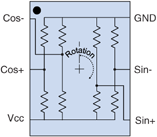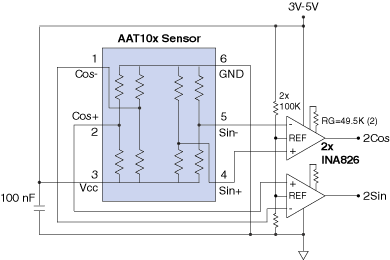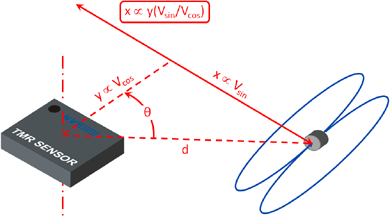| |
|
 |
|

|
Full-Bridge TMR Angle Sensor |
|
|
 The
new AAT101-10E Full-Bridge TMR Angle Sensor is a high-output magnetic sensor for
angle measurements based on rotating magnetic fields. The
new AAT101-10E Full-Bridge TMR Angle Sensor is a high-output magnetic sensor for
angle measurements based on rotating magnetic fields.
The new sensor has two full-bridge push-pull outputs for double the signal. The
full-bridge configuration allows direct replacement of Hall effect sensors for
larger outputs and lower power.
The sensors provide sine and cosine signals defining the angle of rotation. Outputs
are proportional to the supply voltage, and peak-to-peak amplitudes are much larger
than conventional sensors.
Key AAT101 features include:
• Full-bridge differential outputs
• 400 mV/V peak-to-peak output sensitivity
• 625 kΩ device resistance for low power and battery
operation
• Sine and cosine outputs for direction detection
• 1.5% max. nonsinusoidality error
• Ultraminiature 2.5 mm x 2.5 mm x 0.8 mm
TDFN6
Because they are resistive devices with no active components, AAT-Series sensors
have no minimum supply voltage and can be powered from single-cell batteries.
There are now five members of the groundbreaking AAT Angle Sensor family:
Part
Number |
Config. |
Typ.
Output
(ea. output; p-p) |
Min.
Field |
Typ. Device
Resistance |
| AAT001-10E |
Half bridge |
200 mV/V |
30 Oe |
1.25 MΩ |
| AAT003-10E |
Half bridge |
200 mV/V |
30 Oe |
40 KΩ |
| AAT006-10E |
Half bridge |
200 mV/V |
15 Oe |
1.5 MΩ |
| AAT009-10E |
Half bridge |
200 mV/V |
30 Oe |
6 MΩ |
*NEW*
AAT101-10E |
Full bridge |
400 mV/V |
30 Oe |
625 kΩ |
All five part types are in stock and available for immediate delivery.

Evaluation
Kit
The AG934-07E
Evaluation Kit includes a circuit board with an AAT101 angle sensor,
a cylindrical horseshoe magnet, and easy connections.
This video uses the evaluation kit to demonstrate the remarkable AAT101 signal
levels:

Reference
Circuit:
Simple Full-Bridge Sensor Amplifier
AAT101 Angle Sensors have high output signals without amplification, but if single-ended
signals higher amplitude are needed, instrumentation amplifiers can minimize parts
count.
The gain can be limited to about two to avoid saturating the amplifiers:

AAT101 with 2x instrumentation
amplifiers.
|
 |
|
Applications
Corner |
|
|
Linear
Position Sensing with an AAT Sensor
AAT-Series
Tunneling Magnetoresistance (TMR) sensors are normally used as angle sensors,
but they can be used in a configuration like this for linear displacement:

An AAT003 configured as a linear position sensor.
A YouTube Video
shows a live demonstration and the sensors’ remarkable linearity, and includes
a sample microcontroller program.
Micron-scale resolution over a linear range of more than 0.25 inches is practical
with small, inexpensive magnets. Larger or stronger magnets can be used for a
wider linear range, and if exact linearity isn’t needed, just one sensor
output is needed with no math.
This linear position configuration is ideal for electronically-adjustable magnetic
switch points.
AAT sensors have a important advantages for linear position sensing:
| • |
Repeatable, with very low
hysteresis.
|
| • |
Because the measurement
is based on an angle, the output doesn’t depend on magnet strength.
|
| • |
Self-referencing—the
output is zero when the magnet is centered.
|
| •
|
Wide linear sensing range. |
AAT003
sensors are in stock for immediate delivery.

|
|







